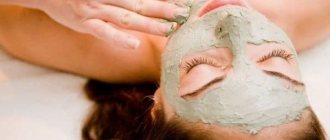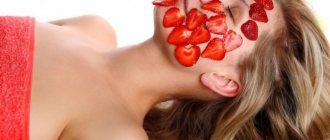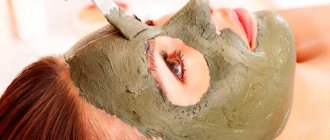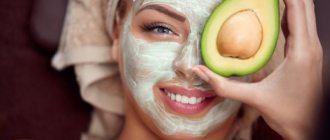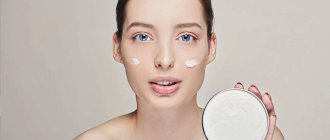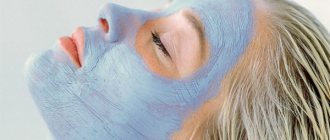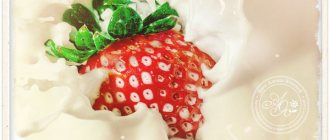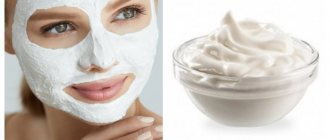Throughout the history of mankind, women have been pursuing beauty and healthy skin. Nowadays, some people resort to complex manipulations in a beauty salon, while others prefer to use inexpensive homemade cosmetics. Among such cosmetics, clay takes pride of place. This inexpensive natural resource is increasingly gaining popularity. You can’t mindlessly apply clay; it’s important to figure out if you have any contraindications.
What you will learn:
- The effects of clay on the skin
- Possible contraindications for use
- The effectiveness of masks - pros and cons
- Properties and quality of clay Can clay cure psoriasis?
How is it good for the skin?
Clay, regardless of color, is an excellent absorbent that cleanses of toxins, fights pathogenic microbes , and when taken orally, improves the blood formula and activates metabolism. Other effects include:
- whitens;
- tones;
- nourishes;
- rejuvenates.
What explains this action of the rock? One of the inherent properties is ion exchange. The ions contained in clay bind cations of excess substances that cause the development of dermatological defects.
Clay also consists entirely of a tiny mixture of minerals, which determine its color and determine its beneficial properties and effects. Which clay is suitable for oily skin? Next - about the varieties that help cope with the imperfections of oily skin, and recipes for masks.
Caution in use
Cosmetic clay is suitable for almost everyone. But, like any natural, active product, clay must be handled with care. It is important to understand that clay cannot cure all diseases. And most of them can be made worse. We suggest you familiarize yourself with the main situations when clay is contraindicated :
- It is strictly forbidden to use clay if your health condition is febrile.
- If you experience pain in the genitourinary area, forget about anti-cellulite masks.
- If acute inflammatory processes occur on the skin or in the body, even blue clay is contraindicated, although it has the greatest number of medicinal properties.
- For osteoporosis, treatment with clay is not prohibited, but is ineffective;
- Itching and burning under the mask is a good reason to wash it off. This does not apply to anti-cellulite masks; the burning sensation there is quite normal.
- Treatment with clay is contraindicated for heart problems.
- It is better to purchase medications rather than clay if you have a fungal infection.
- If the temperature is elevated, then clay on any part of the body will increase it even more.
- Oncological diseases, open form of tuberculosis and clay are incompatible.
- Older people, when all body systems have worn out, should not experiment with clay.
- Clay gets rid of pimples, but for rashes with pustules, masks are not applied. When washing off the mask, there is a high probability of opening the pustules and getting another problem - infection.
- Women on special days, as well as pregnant women, should not use clay.
- For kidney and liver diseases, clay can be used for the face. Some people apply lotions to painful areas. In this case it is useless.
- With rosacea, clay will only do harm.
- If you leave the mask on too long, the skin will peel off and a burn may occur.
- You cannot self-medicate with clay; a visit to a doctor and an integrated approach to the problem are required.
White
This is the main type of rock used in cosmetology to treat oily and problem skin. White clay consists almost entirely of kaolinite, which includes aluminum oxide, silicon dioxide, and water.
It looks like a white powder with a milky yellowish or creamy tint.
Kaolin produces the following effects:
- absorbs sebum;
- dries;
- cleanses pores;
- mattifies;
- additionally - tones, nourishes, smoothes.
Morning cleansing soap
- clay (hereinafter we mean the drug in powder form) - 100 g;
- soda, pharmaceutical boric acid (powder) - 1 tsp of each ingredient.
The products are mixed and transferred to a dry container. In the morning, take a pinch of the mixture, add water, stir to form a paste. Moisten and lather your face with clay, leave for 2 minutes. Then they wash their face, use a toner, then a moisturizing cream for oily skin. This will normalize fat secretion, cleanse pores, and reduce inflammation.
Clay mask for oily skin for nutrition and whitening
To prepare the mask take:
- kaolin - 2 tbsp. l.;
- egg white - 1 pc.;
- water - 3 tbsp. l.;
- lemon juice - 0.5 tsp;
- honey - 1 tsp.
Beat the egg white into a foam, dilute the clay with water, then mix all the ingredients. The mask is smeared on the face and left on for a quarter of an hour.
Mask against inflammation, shine
Includes:
- white clay - 2 tbsp. l.;
- aloe juice - 1 tbsp. l. (or 1 ampoule of extract);
- water - 1 tbsp. l.
A paste of mixed ingredients is applied to the face and left for 15 minutes.
How to make a clay face mask: folk recipes
Depending on the skin type and problem areas that need to be addressed, there are various recipes that can be used to make an effective and safe product. We invite you to consider how to properly make a clay face mask to achieve maximum effect.
- For oily skin care
For oily facial skin, we can recommend kaolin masks, which contain infusions of medicinal herbs, citrus juice, and tea tree ether:
Blue clay mask, antiseptic. First, an infusion of marigolds is made, a tablespoon of which is poured with a glass of boiling water, infused for 20 minutes, and filtered. A tablespoon of blue clay is diluted in a small amount of this infusion. It is used according to the general rules for clay masks.
For problematic skin. Dilute a large spoonful of kaolin with sour milk or curd whey to achieve the desired consistency. Add 3-4 drops of tea tree oil, mix well and use.
To tighten pores. Dilute white clay (a tablespoon) with kefir, add juice from a quarter of a lemon. If the skin is mature, then lemon juice can be replaced with orange juice.
For age-related care. Dilute a spoonful of green clay with an infusion of herbs (sage, chamomile), add a couple of drops of lavender and bergamot oils, add a teaspoon of honey, as well as the white of one chicken egg, beaten into foam. This mask smooths out wrinkles, nourishes, brightens, has an anti-inflammatory effect, and also has a lifting effect.
- For dry skin
For dry dermis, masks with the addition of base and essential oils are used. We offer the simplest, but at the same time very effective:
Kaolin mask with almond oil. You need to combine the clay with milk or cream (in equal quantities), stir so that there are no lumps, add a teaspoon of almond oil (peach oil is also suitable), mix again. Afterwards, if necessary, you should add a little more milk or clay - so that the consistency is like thick sour cream.
Made from blue clay. Dilute a spoonful of blue clay with cucumber juice to the consistency of very thick sour cream (so that the spoon can stand), add a teaspoon of olive oil, stir and use. The mask refreshes, tones and whitens the skin well.
For sensitive skin. Dilute red clay (a large spoon) or a mixture of white and pink (a small heaped spoon each) with chamomile decoction, add a couple of drops of rose oil, half a teaspoon of peach oil, mix and use the composition as a mask.
For mature skin. Mix kaolin with yellow clay in equal proportions, dilute with cream, add a small spoonful of honey and flax oil - the rejuvenating mask for dry epidermis is ready.
- For normal skin
Dilute a tablespoon of kaolin with milk, add a spoonful of sour cream, stir. If desired, add a couple of drops of your favorite essential oil and a little honey.
- Recipe for kaolin mask against aging skin
Sometimes this remedy is called Cleopatra's mask. Suitable for any skin, but the components vary depending on the type of dermis. You need to take two teaspoons of white clay, for dry skin add a spoonful of yellow clay, for normal and oily skin - green clay. Add a teaspoon of oil: grape seed - if the dermis is oily, peach or almond - in other cases. Bring to the optimal consistency by pouring in mineral water and stirring. The composition of the mask is very simple, and the rejuvenating effect is simply amazing.
We have discussed with you how often and correctly you need to make a face mask from clay. Now it’s up to you - it’s time to try the proposed recipes for yourself and feel their effectiveness.
Yellow
The composition, in addition to kaolin, includes sodium, sulfur and their compounds, as well as ferric iron and potassium. Yellow clay:
- destroys pathogenic bacteria that abound in oily skin;
- saturates tissues with oxygen;
- restores elasticity when fading;
- reduces the depth of wrinkles;
- softens.
A special feature of applications made from yellow clay is that they are not allowed to dry out on the skin.
Mask for high fat content
To prepare it take:
- kaolin - 2 tsp;
- bee honey, lemon juice, natural apple vinegar - 1 tsp each.
The components are mixed, water is added as needed to achieve sour cream thickness and homogeneity. The application lasts 10 minutes, then wash.
Blue
The blue color comes from silver molecules, which act as an anti-inflammatory and disinfectant. In part, it took over the properties of white clay, as well as blue, which stimulates cell regeneration.
The composition includes cadmium, cobalt, including in the form of salts, silicon, magnesium, iron, and other minerals.
Cleansing mask
The product first opens and then cleanses pores and gets rid of oily shine. First, grind the rice into powder using a coffee grinder. Then take clay and rice powder in equal parts, add water, and dilute it to the consistency of sour cream. The mixture is left for a quarter of an hour and removed with warm water.
Green
Green clay-based care is also one of the most effective for oily skin. Cosmetics based on it deeply cleanses, tightens pores, reduces the production of fat by glands, helps fight acne and inflammation, and also tones, activates blood circulation, eliminates swelling, and is a natural stimulant.
Contains copper and metal salts, divalent iron.
Mask against inflammatory elements
To prepare it take:
- green clay - 10 g;
- lemon, honey - 5 g;
- tea tree oil - 2-3 drops.
The components are mixed, if the mass is thick, add water. Distribute over the skin, leave for 20 minutes, and wash.
The effectiveness of masks - pros and cons
Clay masks are highly effective provided they use and prepare the skin correctly, as well as the environmental friendliness of the clay itself. The mask will bring many benefits if you choose the right type of clay.
And this depends on the problem you want to solve and the color of the clay due to its composition:
- Pink and gray clays in masks actively enrich the subcutaneous layers, and the skin will be moisturized with regular use .
- Yellow clay is ideal for aging . It absorbs toxic substances from the skin layers.
- Using green clay is the best method to combat acne; thanks to zinc, the clay will dry them out. The antiseptic properties of clay help it disinfect pores and remove oily shine.
- Blue clay fights germs and pigmentation on the skin. This function is due to the presence of silver ions.
- White clay is considered the most traditional It is multifunctional: it tightens the facial contour, disinfects, whitens, smoothes wrinkles, gets rid of cellulite, etc.
- After using red clay masks blood circulation improves , skin turgor increases, and inflammation disappears. The best option for sensitive skin.
Black
The composition includes strontium, quartz, magnesium, calcium, iron and carbon. Black clay improves cellular metabolism better than others. The product is useful for those who have blackheads, comedones, or acne on their face.
By regularly using clay masks for oily skin, you can not only treat, but even completely get rid of rashes.
Anti-blackhead mask
To get rid of comedones, the clay is diluted with water and the paste is applied to the face. After drying slightly, moisten your fingers with water and carefully roll the mass along the massage lines, trying not to stretch the skin. Residues are removed with water. Afterwards they do peeling, for which they take:
- Hercules flakes - 2 tbsp. l.;
- water - 0.1 l.
The flakes are poured with water and allowed to become saturated with moisture. After peeling, wash again.
Acne mask
To reduce the number of rashes, here is a recipe for a homemade anti-inflammatory remedy:
- clay - 1 tsp;
- infusion of string - 2 tbsp. l.
The clay is mixed with a string, the mixture is left on the skin for 15 minutes. After washing, the skin is wiped with infusion from the series.
Possible contraindications for use
The main contraindication is an individual reaction; it most likely occurs not to the clay itself, but to other components of the mask.
If you have chronic skin diseases , clay should not be applied. During the period of remission, you can try a clay mask. It is better to smear it with a thin layer to observe the skin reaction. Any inflammation in the acute phase is a serious reason to postpone clay until later.
Even if you have no contraindications, you can keep a clay mask on your face for no more than 30 minutes .
Watch how you feel; if it starts to sting or sting, wash it off immediately. This is not an allergic reaction, it means that the blood vessels are close to the skin. There is a rush of blood to the skin. Clay is a very powerful product . But it is important not to overdo it with masks, so as not to get the opposite result.
Rules for preparing masks
If a cosmetic product is prepared based on water, then it must be boiled or purified. Temperature is about 40º C; at higher temperatures, kaolinite loses its beneficial qualities.
The basic proportions for preparing masks are as follows: for 2 tbsp. l. clays take 50 ml of water or infusion of herbs intended for oily skin (queenia, sage, eucalyptus, oak bark). To obtain a homogeneous mixture, the liquid is poured into the powder, and not vice versa.
The procedure is carried out in a calm environment so that no one disturbs. When the clay dries, it is important to keep the facial muscles still.
If you constantly ignore the rule, then wrinkles will appear, and it will be painful to talk under a hardened mask. Applications are not applied to areas around the eyes and lips.
Warm water is used to remove clay. When washing, gently massage the skin to remove dead cells. Wet clay acts as a delicate scrub. Then wipe the skin with tonic and apply cream with moisturizing ingredients.
The procedure is carried out three times a week, in the summer it can be every other day , especially if you use decorative cosmetics - powder, foundation, which clog the pores.
To ensure that the powder retains its medicinal properties, store it in a tightly closed bag or container, away from household chemicals and dust.
The clay in a single piece is first crushed to a powdery state, and then sifted through a strainer. If the product is purchased at a pharmacy, then its composition is studied. Under the guise of "colored" kaolin is sometimes sold with additives - activated carbon ("black clay"), crushed herbs, etc.
Such products bring certain benefits to the skin, but the effect of their use is different. In addition, additional components may conflict with additives and cause an allergic reaction.
Properties and quality of clay
On the Internet you can often find discussions about clay and its ability to clog pores. High-quality cosmetics with clay and cosmetic clay, on the contrary, remove oily shine, cleanse and tighten pores.
Low-quality cosmetics, purchased somewhere on the market or “on the market,” in 99% of cases clog pores and harm our skin.
An important feature of clay when used externally and internally is the absorption of toxins and saturation with minerals. But if this strong sorbent is used ineptly, vitamins will be drawn out along with skin “waste”.
Can clay cure psoriasis?
Fans of homemade cosmetics claim that blue clay is used to treat serious skin diseases. Such as psoriasis and eczema.
For such problems, it is better to consult a dermatologist.
You should not pay attention to the obviously overestimated ability of clay to treat the spine, its curvatures and joints, intestinal colic, ulcers and genitourinary diseases. Particularly impressive are the stories about miraculous cures for gynecological diseases and nervous system disorders using clay. It is better not to try such treatment.
Only a doctor can prescribe competent treatment for the above problems, but not an “amateur” of experiments.
